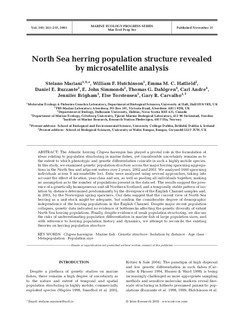| dc.description.abstract | The Atlantic herring Clupea harengus has played a pivotal role in the formulation of
ideas relating to population structuring in marine fishes, yet considerable uncertainty remains as to
the extent to which phenotypic and genetic differentiation coincide in such a highly mobile species.
In this study, we examined genetic population structure across the major herring spawning aggregations
in the North Sea and adjacent waters over 2 years, 2002 and 2003. We analysed 1660 spawning
individuals across 9 microsatellite loci. Data were analysed using several approaches, taking into
account the effect of location, year-class and sex, as well as pooling all individuals together, making
no assumption as to the number of populations present in the data set. The results suggest the presence
of a genetically homogeneous unit off Northern Scotland, and a temporally stable pattern of isolation
by distance determined predominantly by the divergence of the English Channel samples and,
in 2003, by the Norwegian spring spawners. Our data suggest that the current view of North Sea
herring as a unit-stock might be adequate, but confirm the considerable degree of demographic
independence of the herring populations in the English Channel. Despite major recent population
collapses, genetic data indicated no evidence of bottlenecks affecting the genetic diversity of extant
North Sea herring populations. Finally, despite evidence of weak population structuring, we discuss
the risks of underestimating population differentiation in marine fish of large population sizes, and
with reference to herring population history and dynamics, we attempt to reconcile the existing
theories on herring population structure. | no_NO |
